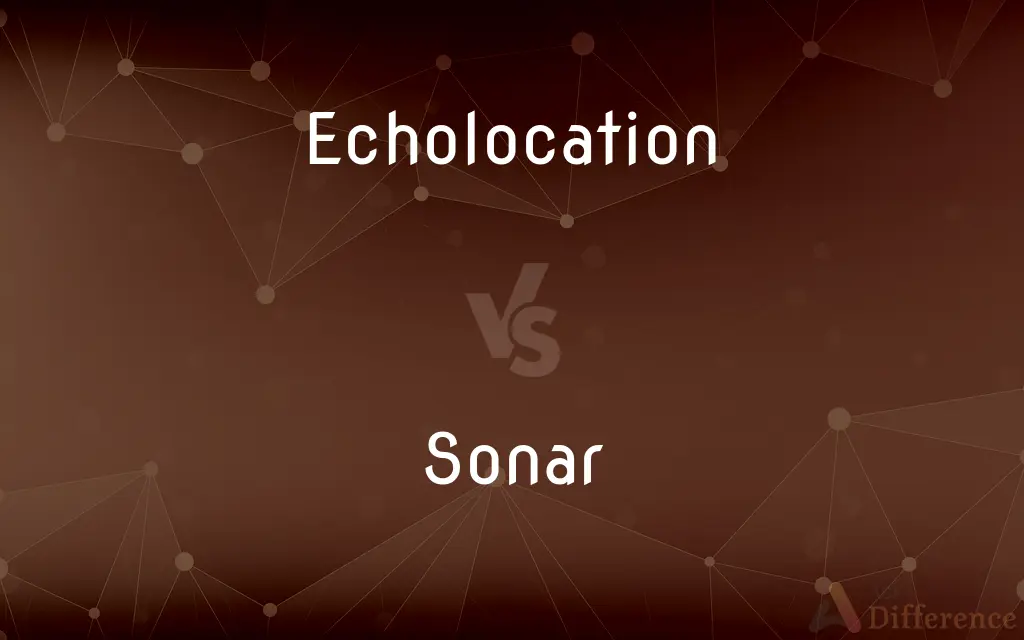Echolocation vs. Sonar — What's the Difference?
By Urooj Arif & Fiza Rafique — Updated on May 3, 2024
Echolocation involves animals emitting sounds to navigate and locate objects by the echoes returned, while sonar is a technology that uses sound waves to detect objects underwater.

Difference Between Echolocation and Sonar
Table of Contents
ADVERTISEMENT
Key Differences
Echolocation is a biological phenomenon where animals like bats and dolphins emit sounds and listen for the echoes that bounce back from objects. This helps them to navigate and hunt in their environment. On the other hand, sonar (Sound Navigation and Ranging) is a technological system used primarily by submarines and ships to locate objects underwater by emitting sound pulses and detecting the echoes returned.
Certain animals have evolved to use echolocation as a means of survival in dark or murky environments where vision is limited. These animals can determine the size, shape, distance, and texture of objects. Whereas, sonar technology is engineered by humans to aid in navigation, object detection, and mapping the ocean floor, utilizing similar principles but through mechanical means.
Echolocation is naturally refined over millions of years of evolution, allowing for complex processing of echo information that can include even the most subtle differences in the echo's return. In contrast, sonar systems, while sophisticated, rely on the precision of technology and can be limited by factors such as water temperature, salinity, and hardware capabilities.
The accuracy and effectiveness of echolocation can vary significantly among different species, with some bats and marine mammals having extremely fine-tuned systems. On the other hand, sonar technology has been designed to meet specific human requirements and can be adjusted according to different operational needs, such as military surveillance or scientific research.
Echolocation operates continuously as a part of an animal's sensory perception, often integrated seamlessly with other senses to provide a holistic view of the environment. Conversely, sonar equipment can be turned on or off and is used intermittently as needed, which can be critical in scenarios like naval operations to avoid detection.
ADVERTISEMENT
While echolocation is limited to certain species, sonar technology is widespread and can be installed on various platforms, from small boats to large naval vessels, and even on stationary underwater installations for continuous monitoring of specific areas.
Comparison Chart
Definition
Biological ability to use sound waves to locate objects
Technological system to detect objects underwater
Primary Users
Bats, dolphins, some birds
Submarines, ships
Functionality
Natural, integral part of the organism
Man-made, operated as needed
Integration
Continuous and integrated with other senses
Intermittent, can be isolated
Adjustability
Fixed, based on species-specific evolution
Highly adjustable and customizable
Compare with Definitions
Echolocation
A sensory method used by certain animals to determine their surroundings by emitting sounds and detecting the echoes.
Bats use echolocation to navigate and hunt insects in complete darkness.
Sonar
Can be used for navigation, object detection, and mapping.
Ships employ sonar to avoid underwater obstacles and navigate safely.
Echolocation
Naturally embedded within the animal's life.
Dolphins echolocate to communicate and identify objects in murky waters.
Sonar
A system that uses sound propagation to navigate, communicate with or detect objects on or under the surface of the water.
Submarines use sonar to detect other vessels underwater.
Echolocation
Varies significantly among species.
Some species of bats have echolocation ranges of up to 100 meters.
Sonar
Engineered to cover large distances, depending on the technology.
Modern sonar systems can detect objects several kilometers away.
Echolocation
Highly refined in some species to detect minute details.
Dolphins can detect size, shape, and texture of objects through echolocation.
Sonar
Affected by water conditions such as temperature and salinity.
Sonar effectiveness decreases in freshwater compared to saltwater.
Echolocation
Dependent on the animal's physiological capabilities.
Not all bats possess equally effective echolocation abilities.
Sonar
Subject to technological enhancements and settings.
Advanced sonar systems can map detailed undersea landscapes.
Echolocation
A sensory system in certain animals, such as bats and dolphins, in which usually high-pitched sounds are emitted and their echoes interpreted to determine the direction and distance of objects.
Sonar
Sonar (sound navigation and ranging) is a technique that uses sound propagation (usually underwater, as in submarine navigation) to navigate, communicate with or detect objects on or under the surface of the water, such as other vessels. Two types of technology share the name "sonar": passive sonar is essentially listening for the sound made by vessels; active sonar is emitting pulses of sounds and listening for echoes.
Echolocation
(Electronics) A process for determining the location of objects by emitting sound waves and analyzing the waves reflected back to the sender by the object. In both senses also called echo ranging.
Sonar
A system using transmitted and reflected underwater sound waves to detect and locate submerged objects or measure the distance to the floor of a body of water.
Echolocation
The use of echoes to detect objects as observed in bats and other natural creatures. Also known as biosonar.
Sonar
An apparatus, as one in a submarine, using sonar.
Echolocation
Determining the location of something by measuring the time it takes for an echo to return from it
Sonar
Echolocation.
Sonar
(nautical) echolocation
Sonar
(nautical) A device that uses hydrophones (in the same manner as radar) to locate objects underwater.
Sonar
A measuring instrument that sends out an acoustic pulse in water and measures distances in terms of the time for the echo of the pulse to return; sonar is an acronym for sound navigation ranging; asdic is an acronym for anti-submarine detection investigation committee
Common Curiosities
How do dolphins use echolocation?
Dolphins emit clicks and listen for the return echoes to determine the location, size, and shape of nearby objects, such as prey and obstacles.
Can humans hear echolocation sounds?
Most echolocation sounds, particularly those made by bats, are in ultrasonic frequencies, which are above the range of human hearing.
Are there different types of sonar?
Yes, there are two main types of sonar: active sonar, which emits sound waves and listens for echoes, and passive sonar, which listens for sounds made by other objects without emitting sounds itself.
What are the limitations of echolocation?
Echolocation can be less effective in noisy environments and is limited by the physical attributes of the echolocating species, such as the frequency and volume of the emitted sounds.
Do any other animals besides bats and dolphins use echolocation?
Yes, certain species of birds, such as oilbirds and swiftlets, and even some small mammals like shrews, use echolocation.
What are the main uses of sonar?
Sonar is primarily used for navigation, detecting underwater objects, conducting geological surveys, and in military applications to locate enemy submarines and mines.
How accurate is sonar compared to echolocation?
While both systems can be highly accurate, sonar technology can be specifically tailored with advanced features for precision, making it generally more versatile and controllable than biological echolocation.
Can sonar be used on land?
Sonar is specifically designed for use in water to utilize sound wave propagation effectively, and it does not work well in air due to different acoustic properties.
How do animals develop echolocation abilities?
Echolocation abilities are developed through natural selection and are finely tuned over generations to suit each species' environmental and survival needs.
What is the range of dolphin echolocation?
Dolphins can typically echolocate objects and other animals up to several hundred meters away, depending on water conditions and the size of the target.
What factors affect sonar performance?
Sonar performance can be affected by water depth, temperature, salinity, bottom composition, and other environmental factors.
How has sonar technology evolved over time?
Sonar technology has evolved from simple echo-sounding equipment to complex systems that can provide detailed images of the underwater environment, enhanced by digital processing and artificial intelligence.
Share Your Discovery

Previous Comparison
Spree vs. Jag
Next Comparison
Limitless vs. UnlimitedAuthor Spotlight
Written by
Urooj ArifUrooj is a skilled content writer at Ask Difference, known for her exceptional ability to simplify complex topics into engaging and informative content. With a passion for research and a flair for clear, concise writing, she consistently delivers articles that resonate with our diverse audience.
Co-written by
Fiza RafiqueFiza Rafique is a skilled content writer at AskDifference.com, where she meticulously refines and enhances written pieces. Drawing from her vast editorial expertise, Fiza ensures clarity, accuracy, and precision in every article. Passionate about language, she continually seeks to elevate the quality of content for readers worldwide.
















































